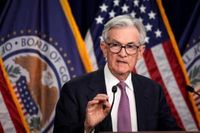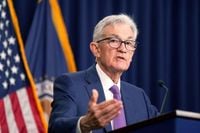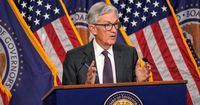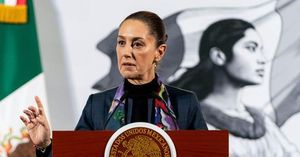On April 16, 2025, Federal Reserve Chair Jerome Powell delivered a crucial speech at the Economic Club of Chicago, addressing the current state of the U.S. economy amid heightened uncertainty due to evolving trade policies and inflationary pressures. Powell's remarks came as markets reacted to significant shifts in consumer sentiment and economic forecasts, particularly in light of recent tariffs imposed by the Trump administration.
During his address, Powell stated, "Despite heightened uncertainty and downside risks, the U.S. economy is still in a solid position." However, he acknowledged that consumer spending has only grown modestly and that a surge in imports to evade tariffs is likely to negatively impact gross domestic product (GDP) estimates. He noted, "The data in hand so far suggest that growth has slowed in the first quarter from last year’s solid pace." This statement underscored concerns that the economy might be entering a period of stagnation.
Powell's comments come at a time when the cryptocurrency market has also been experiencing turmoil. On the same day, Bitcoin prices plummeted over 3%, dropping from approximately $84,000 to around $74,000. Other major cryptocurrencies like XRP, Dogecoin, Cardano, and Chainlink saw declines of more than 4%, while several smaller altcoins fell by about 10%. Analysts attribute this volatility partly to the uncertainty surrounding Powell's speech and the retail sales data for March, which was released that day.
Economists had predicted a 1.2% increase in retail sales for March, up from a mere 0.2% in February. However, the actual figures are still being digested by investors, who are bracing for further market fluctuations. The uncertainty surrounding the economic outlook has left many traders apprehensive about potential short-term selling pressure in risk assets, including cryptocurrencies.
In his speech, Powell reiterated that the Federal Reserve is well-positioned to wait for clearer policy signals before making any adjustments to interest rates. Currently, the Fed's benchmark interest rate remains set between 4.25% and 4.5%, a rate that has been maintained since December 2024. Powell emphasized that the Fed's approach would depend on whether inflationary pressures from tariffs are temporary or more persistent.
"Tariffs are highly likely to generate at least a temporary rise in inflation," Powell remarked, indicating that the central bank must carefully navigate the challenges posed by rising prices while also considering the labor market, which he described as being in solid condition and near maximum employment.
However, the Fed faces a critical juncture. Should inflation continue to rise alongside unemployment, Powell indicated that the Fed would have to weigh the distance from its dual mandates of price stability and full employment. This balancing act is further complicated by the recent tariff policies introduced by President Trump, which have resulted in significant market disruptions.
The World Trade Organization (WTO) also weighed in on the economic situation, sharply cutting its forecast for global merchandise trade. The WTO warned that the ongoing tariff war could lead to the heaviest slump in trade since the peak of the COVID-19 pandemic. This stark prediction adds to the growing concerns about the sustainability of economic growth in the U.S. and globally.
Powell's speech highlighted the Fed's commitment to monitoring the evolving economic landscape closely. He acknowledged that the impacts of recent trade policy changes are still unfolding and could be larger than initially anticipated. As he stated, "As we learn more, we will continue to update our assessment," indicating that the Fed is prepared to adapt its strategies as necessary.
In the backdrop of Powell's address, financial markets reacted with caution. The S&P 500 index experienced a decline of about 1.7% during the session, reflecting concerns over the economic outlook and the potential implications of Powell's comments on interest rates. Investors are particularly sensitive to any signals that suggest the Fed might adopt a more hawkish stance, which could lead to higher borrowing costs and dampen consumer spending.
As the speech concluded, market participants were left to ponder the implications of Powell's remarks and the broader economic environment. With inflation concerns looming and consumer sentiment souring, the Fed's next steps will be closely scrutinized. The central bank's ability to navigate these challenges will be critical in shaping the economic landscape in the months ahead.
In summary, Powell's address on April 16, 2025, painted a complex picture of the U.S. economy, balancing signs of resilience against the backdrop of rising inflation and trade uncertainties. As the Fed prepares to respond to these challenges, all eyes will remain on both the central bank's policy decisions and the evolving market conditions.







